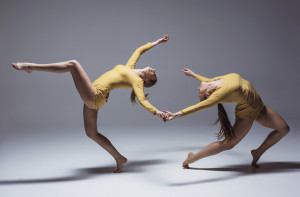The sphere is Laban’s model for the space adjacent to the mover’s body. The center of gravity of the body is also the center of the kinesphere, which extends equally in all directions, establishing a boundary based on the areas of space that can be reached without taking a step.
According to Laban, “all points of the kinesphere can be reached by simple movements, such as bending, stretching, and twisting, or by a combination of these.”
Laban’s choreutic prototypes exploit this spherical movement space using symmetrical trace-forms that oscillate up and down, from side to side, and in front and behind the body.
Since this perfect sphere extends equally in all directions from the center of the body, theoretically there is as much movement space behind the body as there is in front. However, our Prototype Project motion capture and video records indicated that the actual kinesphere is not a perfect sphere but a more lopsided bubble that extends farther in front of the body than behind.
This stands to reason, because the construction of our limbs makes it harder to reach behind the body. Laban certainly was aware of this. But he was an idealist. His kinesphere and his highly symmetrical choreutic trace-forms represent human movement potential. Even our well-rehearsed dancers were not fully able to actualize this potential range of motion (although this was partly because the motion capture suit made footing uneven due to sensor attachments on the dancer’s feet).

As the accompanying photo shows, reaching deeply behind the body is possible, if something of a virtuoso feat. Is Laban’s idealized kinesphere meant to foster virtuosity? No, he merely wants us to be well-rounded. As Laban stresses, “ A healthy human being can have complete control of his kinesphere.” He goes on to note that some restrictions in free use of areas of the kinesphere can be caused by lack of exercise, weakness, anxiety, or timidity. However,“the essential thing is that we should neither have preference for nor avoid certain movements [or areas of the kinesphere] because of physical or psychical restrictions.”
